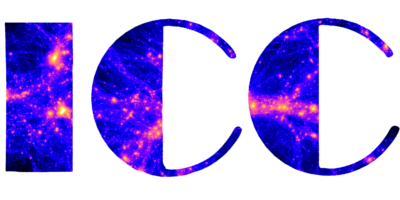AGN - ACTIVE GALACTIC NUCLEI
Please see SUPERMASSIVE BLACK HOLES.
BARYON
Baryons are the building blocks of normal matter. All of the stars, planets (and us) are built from baryons. Baryons are made up of neutrons and protons that are found in the nucleus of all atoms. Big Bang nucleosynthesis explains how these elementary particles formed in the very early Universe. Most of the baryons in the Universe are locked-up in Hydrogen and Helium, with (relatively) small amounts in the heavier elements (such as Carbon, Nitrogen, Oxygen). These heavier elements are nucleosynthetic produce of stars.
BIG BANG
Evidence that the Universe emerged from a period when it was very hot and very dense - a hot Big Bang, is based on three pillars: (1) the observed expansion of the Universe, (2) the fact that Hydrogen and Helium are very abundant in the Universe, since they - unlike other elements - formed during Big Bang nucleosynthesis, (3) the properties of the Cosmic Microwave Background. The Big Bang occurred around 13.7 billion years ago.
CLUSTERS OF GALAXIES
A cluster of galaxies is a dense concentration of galaxies, usually containing hundreds to many thousands of galaxies, dark matter and gas. Galaxy clusters are the most massive structures in the Universe and are held together by gravity. The Coma cluster is an example of a massive, nearby Galaxy Cluster.
COSMIC MICROWAVE BACKGROUND
The Cosmic Microwave Background (CMB) represents a snapshot of the very early Universe. In the early Universe, matter and radiation were in thermal equilibrium because photons kept colliding with electrons. As a result, matter and radiation cooled down at the same rate as the Universe expands.
By a redshift of around 1100 (or 300,000 years after the Big Bang), Hydrogen in the Universe recombines - binding electrons with protons in Hydrogen atoms - leaving no free electrons
for photons to bounce of. These photons stream through the Universe and now make up the CMB. The CMB has a characteristic black body spectrum and was predicted on theoretical grounds by Gamov, and accidentally discovered by Penzias and Wilson.
DARK MATTER
The existence of dark matter was first postulated by Fritz Zwicky in the 1930s to explain the high speeds with which galaxies move inside clusters of galaxies. These high speeds are a consequence of the gravitational forces generated by the dark matter, and felt by the galaxies. In the 1970s, Vera Rubin suggested that dark matter is also the reason that stars in galaxies such as the Milky Way move on circular orbits with speeds independent of their distance to the centre. Observations of clusters of galaxies using gravitational lensing also suggest they are dominated by dark matter.
The dark in dark matter refers to the fact that this mass does not interact measurably with radiation (light) - unlike the normal matter that makes stars, galaxies and people. It is presently unclear how an elementary dark matter particle fits into the standard model of particle physics.
Observations of the Cosmic Microwave Background by the WMAP satellite have also shown that most of the mass in the Universe is dark matter.
If we do not include dark matter in the simulations, the computer model fails to make galaxies that look anything like the real Universe.
ELLIPTICAL GALAXY
Please see GALAXY.
EXPANSION OF THE UNIVERSE
Distant galaxies appear to be moving away from us, with speed increasing with distance. This was first demonstrated by Edwin Hubble in the 1920’s. What is actually observed is that wavelengths of known spectral features increase with increasing distance, just as would happen if these galaxies were moving away from us. However in cosmology this effect is described geometrically, as in Einstein’s theory of general relativity.
In EAGLE, this expansion of the Universe is described using the Friedman-Robertson-Walker metric, including a cosmological constant to describe cosmic acceleration. In this way, the physical length of the EAGLE box increases over time, reaching 100 Mpc at the current time.
In the movies on this website, that size of the EAGLE box is always scaled to be 100 Mpc - this is why the expansion of the Universe in not apparent in the movies.
GADGET
The EAGLE simulations uses GADGET, a computer program written by Volker Springel. The main physical laws GADGET encodes are gravity - which pulls the dark matter, gas, stars, and black holes together, and hydrodynamics - which describes how a gas behaves under different temperatures, pressures and densities. For example, EAGLE calculates how gas cools and collapses to form stars; how gas is heated by radiation from young, hot stars; how stars evolve from their birth to their death, and how black holes form, grow and affect their surroundings.
GALAXY
A galaxy is a collection of stars and gas, held together by dark matter, although a precise definition is not generally agreed upon! Our Sun belongs the Milky Way Galaxy, which is a spiral galaxy which is very similar to the Andromeda galaxy. Both galaxies contain around 150 billion stars, most of which are in a relatively thin disc with spiral arms. The Milky Way forms new stars at a rate of around 2 per year, usually in massive clouds of molecular gas inside the spiral arms. An example of this can also be seen in this beautiful image of the nearby galaxy M83.
Galaxies come in different shapes and sizes. For example, Elliptical galaxies are typically old, round, and do not form stars. NGC 4881 in the Coma cluster is a particularly nice example. The Hubble Sequence provides us with one way to classify galaxies into ellipticals or spirals. The observable Universe is thought to contain 100 billion galaxies with masses equal to or greater than that of the Milky Way galaxy. The Galaxy Zoo projectallows you to classify galaxies.
LARGE-SCALE STRUCTURE
Galaxies are not simply sprinkled randomly throughout the Universe, but follow filamentary patterns with clusters of galaxies at the intersections between filaments. In EAGLE, such structures result from the gravitational force acting on the dark matter.
LOCAL GROUP
The Milky Way and Andromeda, together with several dozen smaller galaxies, form the Local Group. Most spiral galaxies are part of small concentrations of galaxies, which are held together by gravity.
MILKY WAY GALAXY
The Sun is part of the disc of the Milky Way galaxy. On a dark night, you can see the light from the Milky Way’s stars as a faint band of light, but its bulge is obscured by dust.
PARSEC
Parsec (pc) is a measure of distance. 1 parsec corresponds to approximately 3.26 light years.
SIMULATION
A computer simulation calculates how a model for a physical object - in our case the whole Universe - evolves from a starting point, using a computer program that encodes the laws of physics. The physical system itself is characterised by its physical laws, and its starting point (initial conditions). Computer simulations vary from computer programs that run in a few minutes on a single desktop, to hundreds (even thousands) of hours on some of the most powerful “supercomputers” on Earth.
SPIRAL GALAXY
Please see GALAXY.
SUPERMASSIVE BLACK HOLES
Supermassive black holes lurk in all galaxies which have masses comparable (or more) than the Milky Way. Supermassive black holes are relativistic objects with masses ranging from millions to billions of times that of the Sun. One of the pieces of evidence that the Milky Way harbours a massive black hole (with a mass of around 4,000,000 times that of the Sun) is based on observations of motions of stars in the galactic centre. The origin of these exotic objects is poorly understood.
Supermassive black holes can grow in mass by accreting gas, and by merging with other black holes. When they accrete gas, for example during a galaxy merger, they can occasionally become active and become a quasar such as might have happened in the case of quasar 1229, or a radio-galaxy such as Fornax A.
In EAGLE such violent outburst from the supermassive black hole limit star formation in massive galaxies by expelling gas (the raw fuel for star formation) from the galaxy. This makes them a crucial ingredient of the simulation. Without black holes, the simulation forms galaxies that are much more massive than any observed galaxy.
SUPERNOVA
Supernovae (the plural of supernova) are the end points of stellar evolution - when stars “die”. A supernova event occurs when a star “explodes”. Supernovae can be extremely bright, sometimes outshining the whole galaxy for one to two weeks. The supernova in M82 is a recent example. Our own Milky Way galaxy harbours dozens of supernova remnants - the shrapnel from the explosion - for example the Crab nebula.
Observationally there are (at least) two main types of Supernovae: (i) type Ia, which occur as a result of mass transfer from a massive star in a binary system onto a white dwarf star which becomes unstable and produces the supernova and (ii) type II supernova, which occur when the core of a massive star becomes unstable. Apart from being very energetic, supernovae are thought to be the channel through which elements more massive than Iron (such as Uranium or Plutonium) are produced.
In EAGLE, supernovae are crucial because they produce (and release) huge amounts of energy. A supernova produces the same amount of energy in a few weeks as the Sun produces in 10 billion years. In EAGLE, this energy heats the gas, and quenches the star formation by “kicking” the gas out of the galaxy. Without supernovae, the simulation forms far too many stars, producing galaxies that look nothing like those we observe in the real Universe.















